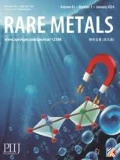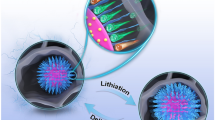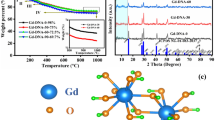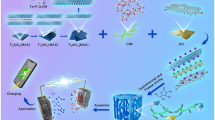Abstract
Recently, CoCO3 has attracted enormous attention as anodes for lithium-ion batteries (LIBs), benefiting from its high theoretical capacity and simple synthesis. However, the modest electronic conductivity and structural instability over cycling hinder its wider applications. To well address the intrinsic issues, we explored a precipitant-free hydrothermal methodology for mass production of spindle-like CoCO3/reduced graphene oxide (S-CoCO3/rGO) toward advanced LIBs as a hybrid anode. The dimethylformamide plays a significant role of “two birds (i.e., solvent and precipitant) with one stone” in the formation of the S-CoCO3/rGO, greatly improving its practical applicability. The purposeful introduction of rGO nanosheets as a two-dimensional flexible conductive network enhances the conductivity and stability of the S-CoCO3. It is the structural and compositional merits for LIBs that endow the S-CoCO3/rGO with remarkable lithium-storage performance in terms of enhanced interfacial storage capacity, high-rate reversible capacities (803 mAh·g−1 at 2.0 A·g−1) and long-duration capacity retention of 82.1% over 2000 consecutive cycles at 2.0 A·g−1. More significantly, the simple yet efficient avenue here promises enormous commercial prospect of the S-CoCO3/rGO in next-generation LIBs.







Similar content being viewed by others
References
Sun CW, Rajasekhara S, Goodenough JB, Zhou F. Monodisperse porous LiFePO4 microspheres for a high power Li-ion battery cathode. J Am Chem Soc. 2011;133(7):2132.
Yuan CZ, Yang L, Hou LR, Li JY, Sun YX, Zhang XG, Shen LF, Lu XJ, Xiong SL, Lou XW. Flexible hybrid paper made of monolayer Co3O4 microsphere arrays on rGO/CNTs and their application in electrochemical capacitors. Adv Funct Mater. 2012;22(12):2560.
Wang BP, Lv R, Lan DS. Preparation and electrochemical properties of Sn/C composites. Rare Met. 2019;38(10):996.
Zhang SS. Identifying rate limitation and a guide to design of fast-charging Li-ion battery. InfoMat. 2019. https://doi.org/10.1002/inf2.12058.
Chen D, Tan HT, Rui XH, Zhang Q, Feng YZ, Geng HB, Li CC, Huang SM, Yu Y. Oxyvanite V3O5: a new intercalation-type anode for lithium-ion battery. InfoMat. 2019;1(2):251.
Zeng C, Xie FX, Yang XF, Jaroniec M, Zhang L, Qiao SZ. Confined transformation derived ultrathin titanate nanosheets/graphene films for excellent Na/K ion storage. Angew Chem Int Ed. 2018;130(28):8676.
Zhao Y, Li XF, Yan B, Xiong DB, Li DJ, Lawes S, Sun XL. Recent developments and understanding of novel mixed transition-metal oxides as anodes in lithium ion batteries. Adv Energy Mater. 2016;6(8):1502175.
Zhao SQ, Wei SS, Liu R, Wang YX, Yu Y, Shen Q. Cobalt carbonate dumbbells for high-capacity lithium storage: a slight doping of ascorbic acid and an enhancement in electrochemical performances. J Power Sources. 2015;284(15):154.
Zhang CC, Liu WJ, Chen DY, Huang JY, Yu XY, Huang XY, Fang YP. One step hydrothermal synthesis of FeCO3 cubes for high performance lithium-ion battery anodes. Electrochim Acta. 2015;182(10):559.
Zhong YR, Yang M, Zhou XL, Luo YT, Wei JP, Zhou Z. Orderly packed anodes for high-power lithium-ion batteries with super-long cycle life: rational design of MnCO3/large-area grapheme composites. Adv Mater. 2015;27(5):806.
Eames C, Islam MS. Ion intercalation into two-dimensional transition-metal carbides: global screening for new high-capacity battery materials. J Am Chem Soc. 2014;136(46):16270.
Liu JD, Liang JJ, Wang CY, Ma JM. Electrospun CoSe@N-doped carbon nanofibers with highly capacitive Li storage. J Energy Chem. 2019;33:160.
Yang D, Zhu JX, Rui XH, Tan HT, Cai R, Hoster HE, Yu DYW, Hng HH, Yan QY. Synthesis of cobalt phosphides and their application as anodes for lithium ion batteries. ACS Appl Mater Interfaces. 2013;5(3):1093.
Stan MC, Klöpsch R, Bhaskar A, Li J, Passerini S, Winter M. Cu3P binary phosphide: synthesis via a wet mechanochemical method and electrochemical behavior as negative electrode material for lithium-ion batteries. Adv Energy Mater. 2012;3(2):231.
Wu SJ, Wu ZH, Fang S, Qi XP, Yu B, Yang JY. A comparison of core–shell Si/C and embedded structure Si/C composites as negative materials for lithium-ion batteries. Rare Met. 2019. https://doi.org/10.1007/s12598-019-01354-8.
Zhao ZW, Wang ZL, Denis DK, Sun X, Zhang JY, Hou LR, Zhang XG, Yuan CZ. Intrinsic lithium storage mechanisms and superior electrochemical behaviors of monodispersed hierarchical CoCO3 sub-microspheroids as a competitive anode towards Li-ion batteries. Electrochim Acta. 2019;307(1):20.
Zhao SQ, Wang ZW, He YJ, Jiang HR, Harn YW, Liu XQ, Su CL, Jin HL, Li Y, Wang S, Shen Q, Lin ZQ. A Robust Route to Co2(OH)2CO3 ultrathin nanosheets with superior lithium storage capability templated by aspartic acid-functionalized graphene oxide. Adv Energy Mater. 2019;9(26):1901093.
Garakani MA, Abouali S, Zhang B, Takagi CA, Xu ZL, Huang JQ, Huang JQ, Kim JK. Cobalt carbonate/and cobalt oxide/graphene aerogel composite anodes for high performance Li-ion batteries. ACS Appl Mater Interfaces. 2014;6(21):18971.
Huang GY, Xu SM, Yang Y, Sun HY, Li ZB, Chen Q. Micro-spherical CoCO3 anode for lithium-ion batteries. Mater Lett. 2014;131(15):236.
Su LW, Zhou Z, Qin X, Tang QW, Wu DH, Shen PW. CoCO3 submicrocube/graphene composites with high lithium storage capability. Nano Energy. 2013;2(2):276.
Du HM, Jiao LF, Wang QH, Huan QN, Guo LJ, Si YC, Wang YJ, Yuan HT. Morphology control of CoCO3 crystals and their conversion to mesoporous Co3O4 for alkaline rechargeable batteries application. CrystEngComm. 2013;15(30):6101.
Ding ZJ, Yao B, Feng JK, Zhang JX. Enhanced rate performance and cycling stability of a CoCO3-polypyrrole composite for lithium ion battery anodes. J Mater Chem A. 2013;1:11200.
Shi SJ, Zhang M, Liu YY, Hua XY, Guo HT, Yang G. Efficient construction of a CoCO3/graphene composite anode material for lithium-ion batteries by stirring solvothermal reaction. Ceram Int. 2018;44(4):3718.
Li HY, Tseng CM, Yang CS, Lee TC, Su CY, Hsieh CT, Chang JK. Eco-efficient synthesis of highly porous CoCO3 anodes from supercritical CO2 for Li+ and Na+ storage. Chemsuschem. 2017;10(11):2464.
Ma JZ, Zhang JT. Surface coating of electrocatalysts boosts battery performance. Rare Met. 2020. https://doi.org/10.1007/s12598-020-01419-z.
Zhu MY, Kan JR, Pan JM, Tong WJ, Chen Q, Wang JC, Li SJ. One-pot hydrothermal fabrication of alpha-Fe2O3@C nanocomposites for electrochemical energy storage. J Energy Chem. 2019;28:1.
Wu MG, Liao JQ, Yu LX, Lv RT, Li P, Sun WP, Tan R, Duan XC, Zhang L, Li F, Kim JY, Shin KH, Park HS, Zhang WC, Guo ZP, Wang HT, Tang YB, Goegolis G, Galiotis C, Ma JM. Roadmap on carbon materials in energy storage and conversion. Chem Asian J. 2020. https://doi.org/10.1002/asia.201901802.
Chang XQ, Zhou XL, Ou XW, Lee CS, Zhou JW, Tang YB. Ultrahigh nitrogen doping of carbon nanosheets for high capacity and long cycling potassium ion storage. Adv Energy Mater. 2019;9(47):1902672.
Kucinskis G, Bajars G, Kleperis J. Graphene in lithium ion battery cathode materials: a review. J Power Sources. 2013;240:66.
Wang Y, Kong DZ, Shi WH, Liu B, Sim GJ, Ge Q, Yang HY. Ice templated free-standing hierarchically WS2/CNT-rGO aerogel for high-performance rechargeable lithium and sodium ion batteries. Adv Energy Mater. 2016;6(21):1601057.
Liu Y, Fang YJ, Zhao ZW, Yuan CZ, Lou XW. A ternary Fe1-xS@porous carbon nanowires/reduced graphene oxide hybrid film electrode with superior volumetric and gravimetric capacities for flexible sodium ion batteries. Adv Energy Mater. 2019;9(9):1803052.
Dai HM, Xia BQ, Wen L, Du C, Su J, Luo W, Cheng GZ. Synergistic catalysis of AgPd@ZIF-8 on dehydrogenation of formic acid. Appl Catal B. 2015;165:57.
Concha BN, Eugenio C, Carlos MG. Controllable coverage of chemically modified graphene sheets with gold nanoparticles by thermal treatment of graphite oxide with N, N-dimethylformamide. Carbon. 2013;54:201.
Sun Q, Li DP, Cheng J, Dai LN, Guo JG, Liang Z, Ci LJ. Nitrogen-doped carbon derived from pre-oxidized pitch for surface dominated potassium-ion storage. Carbon. 2019;155:601.
Vicarelli L, Heerema SJ, Dekker C, Zandbergen HW. Controlling defects in graphene for optimizing the electrical properties of graphene nanodevices. ACS Nano. 2015;9(4):3428.
Xiao L, Wang SY, Wang YF, Meng W, Deng BH, Qu DY, Xie ZZ, Liu JP. High-capacity and self-stabilized manganese carbonate microspheres as anode material for lithium-ion batteries. ACS Appl Mater Interfaces. 2016;8(38):25369.
Jamnik J, Maier J. Nanocrystallinity effects in lithium battery materials. Aspects of nano-ionics. Part IV. Phys Chem Chem Phys. 2003;5(4):5215.
Reddy MV, Subba Rao GV, Chowdari BVR. Metal oxides and oxysalts as anode materials for Li ion batteries. Chem Rev. 2013;113(7):5364.
Acknowledgements
This work was financially supported by the National Natural Science Foundation of China (Nos. 51772127 and 51772131), the Taishan Scholars (No. ts201712050), the Major Program of Shandong Province Natural Science Foundation (No. ZR2018ZB0317), the Natural Science Doctoral Foundation of Shandong Province (No. ZR2019BEM038), the Natural Science Doctoral Foundation of the University of Jinan (No. XBS1830) and the Collaborative Innovation Center of Technology and Equipment for Biological Diagnosis and Therapy in Universities of Shandong.
Author information
Authors and Affiliations
Corresponding authors
Electronic supplementary material
Below is the link to the electronic supplementary material.
Rights and permissions
About this article
Cite this article
Wang, YY., Zhao, ZW., Liu, Y. et al. Precipitant-free solvothermal construction of spindle-like CoCO3/reduced graphene oxide hybrid anode toward high-performance lithium-ion batteries. Rare Met. 39, 1082–1091 (2020). https://doi.org/10.1007/s12598-020-01464-8
Received:
Revised:
Accepted:
Published:
Issue Date:
DOI: https://doi.org/10.1007/s12598-020-01464-8




